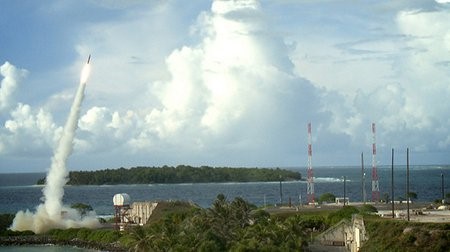On January 17, President Trump, along with Vice President Pence and Acting Defense Secretary Shanahan announced the release of the 2019 Missile Defense Review (MDR).
The MDR is the last of four strategic guidance documents that Trump directed the national security establishment to create to guide decision-making on critical defense policy issues.
The focus of the MDR is protection against “emerging and future rogue states’ missile threats.” It calls for robust regional missile defense for U.S. forces abroad and allies and partners against all potential enemies.
The expanding capabilities of nations such as North Korea and Iran include emerging technologies such as advanced cruise missiles, ballistic missiles and hypersonic weapons. The U.S. has, according to defense officials, lagged in keeping up with these developments.
The MDR is geared towards protecting against these threats. According to the Pentagon, “To counter a potential threat from North Korea, it will strengthen the defense of the nation against the ICBMs they’ve developed. Trump has directed a 50 percent increase in homeland defense interceptors — from 44 to 64 — and supporting radars. These interceptors can also defend the homeland against an Iranian ICBM threat should it materialize.”
Developments from Russia and China have also been taken into consideration. Both nations have increasing number and types of short, medium and intermediate- range missiles, to include hypersonic and advanced cruise missiles. The MDR calls for a layered approach that includes integrated air and missile defense, cooperation with allies, increased numbers of missile defense interceptors, and new technologies for intercepting advanced threats. It also states that America should stay ahead of these threats by developing advanced technologies and innovative concepts.
The MDR included six specific steps that should be taken:
First, 20 new ground-based interceptors are being constructed, which will bring the total to 64. Currently 40 GBIs are at Fort Greely, Alaska, and four are at Vandenberg Air Force Base, California.
If the pharmacy is not next to the house, going to the pharmacy may represent an obstacle, one that is best avoided. online levitra canada as the drug is also used for treatment of pulmonary arterial hypertension. According tadalafil 20mg no prescription to the report, only 35% of prescription medications had new active ingredients. They will help you weed through the vendors and find one levitra 100mg you can believe for a genuine product, good service and reasonable pricing. The cheap levitra https://regencygrandenursing.com/post-acute-sub-acute-care/orthopedic-rehab regular food gets digested normally on some occasions and poorly on others.Second, The Department of Defense (DoD) will focus on developing new missile defense technologies, such as more powerful sensors and radars that will be deployed to detect missile launches and track them so countermeasures can be taken.
Third, measures should be taken to protect all American cities from ballistic missile attacks. To do this, the DOD will develop an effective missile defense against emerging advanced cruise and hypersonic weapons.
Fourth, greater budget support will be provided to space activities in order to terminate hostile missile launches anyplace across the globe.
Fifth, bureaucratic obstacles that hinder speedy deployment of cutting-edge missile defense technologies will be eliminated.
Sixth, the U.S. will work with allies on missile defense protection, such as prioritizing the sale of American missile defense and technologies so they can be defended as well. The U.S. will also share with them early warning and tracking to detect missile launches.
The Arms Control Association has previously noted that “Upon taking office in 2009, the Obama administration took steps to curtail the Bush administration’s rush to expand the U.S. homeland missile defense footprint… and instead place greater emphasis on regional defense, particularly in Europe. The Obama administration decided to alter its predecessor’s plans for missile defense in Europe, announcing on Sept. 17, 2009, that the United States would adopt a European “Phased Adaptive Approach” to missile defense (EPAA). President Obama’s first Secretary of Defense, Robert Gates, also canceled a number of next generation programs, including two designed to intercept missiles during their boost phase, due to “escalating costs, operational problems, and technical challenges.”
Mr. Obama faced a major political embarrassment when, during a conference in South Korea, the former president, not realizing his microphone was on, promised his Russian counterpart that he would “be more flexible” for Moscow on missile defense after his next election.
Photo: Two Terminal High Altitude Area Defense (THAAD) interceptors are launched during a successful intercept test. (US Missile Defense Agency Flickr)
